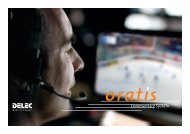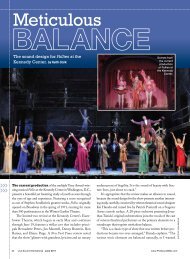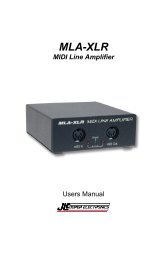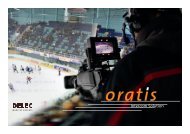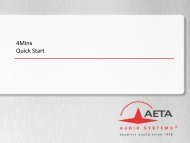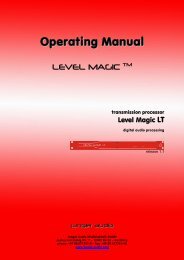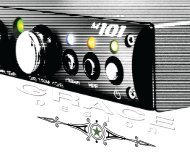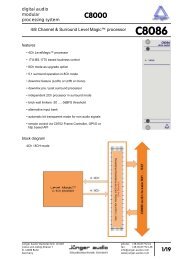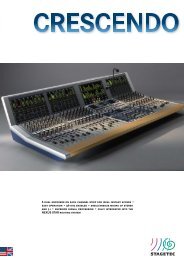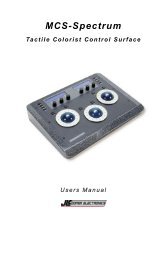Digital Solutions BVE02 User Manual - PDF - Aspen Media.
Digital Solutions BVE02 User Manual - PDF - Aspen Media.
Digital Solutions BVE02 User Manual - PDF - Aspen Media.
You also want an ePaper? Increase the reach of your titles
YUMPU automatically turns print PDFs into web optimized ePapers that Google loves.
<strong>Digital</strong> <strong>Solutions</strong><br />
<strong>BVE02</strong><br />
ESAM Interface<br />
Owner’s <strong>Manual</strong><br />
January 2010
OPERATIONAL OVERVIEW 4<br />
<strong>BVE02</strong>-PV 4<br />
<strong>BVE02</strong>-AFV 4<br />
Basic Operation 4<br />
Preview and Monitor Operations 5<br />
Channel Fader Level Adjustments 6<br />
Mixer ESAM Control Enable 6<br />
Master Fader Control 6<br />
<strong>BVE02</strong>-PV 7<br />
Preview Audio Control 7<br />
Remote Preview Control 7<br />
Multiple Audio Sources 7<br />
SET-UP 8<br />
Yamaha Mixer Setup 8<br />
Mixer Configuration 8<br />
<strong>BVE02</strong> Interface 10<br />
<strong>BVE02</strong>-PV 10<br />
EDIT CONTROLLER SETUPS 11<br />
Sony BVE9100 11<br />
Sony BVE2000 12<br />
SONY BVE910 12<br />
System Configuration Security 12<br />
MONITORING 13<br />
Edit Suite Monitoring 13<br />
Very Simple Monitoring 13<br />
Simple 2 Channel Monitoring 13<br />
Sophisticated 4 or 8 Channel Monitoring 13<br />
Edit Suite Monitoring Operation 14<br />
Monitor 14<br />
Edit Preview 14<br />
Edit 14<br />
LIVE MONITOR SETUP WITH <strong>BVE02</strong>-PV 15<br />
LIVE STUDIO GALLERY MONITOR OPERATION 15<br />
Program Monitor 15<br />
Audio Preview Monitor 15<br />
INTERNAL DIP SWITCH SETUP 16<br />
MACHINE ASSIGNMENTS 16<br />
2
CONNECTIONS. 17<br />
<strong>BVE02</strong> D-type Connector Configuration. 17<br />
Yamaha DM1000 and DM2000 Mixer Remote Connector Configuration 17<br />
<strong>BVE02</strong> to Yamaha 02R96 Mixer Cable Specification 17<br />
<strong>BVE02</strong> to Yamaha DM1000 and DM2000 Mixer Cable Specification 18<br />
Editor or Switcher to <strong>BVE02</strong> Cable Wiring Specification 18<br />
TROUBLESHOOTING. 19<br />
UPLOADING NEW CODE TO THE <strong>BVE02</strong> 21<br />
Uploading New Code 21<br />
APPENDIX A - ELECTROMAGNETIC COMPATIBILITY 24<br />
3
Operational Overview<br />
The <strong>Digital</strong> <strong>Solutions</strong> <strong>BVE02</strong> interface enables a Yamaha DM1000, 02R96 or DM2000 digital<br />
recording console to be controlled by a Video Edit Controller or Vision Switcher using the<br />
ESAM command protocol.<br />
When connected to a Video Edit Controller, the mixing and monitoring of forty channels of<br />
source audio may be controlled directly from the edit controller, with all edits and crossfades<br />
stored and recalled as part of the edit decision list (EDL) held on the Edit Controller.<br />
When connected to a Vision Switcher, the <strong>BVE02</strong> automatically mixes the audio channels for<br />
sources selected to the Program bus on the Vision Switcher.<br />
In both scenarios, the audio mixer may be used with two or four audio-channel VTRs, servers,<br />
cameras or Outside Sources and will mix signals to a two, four or eight channel mix bus.<br />
The versatile system display and the motorised channel faders of the mixer enable the status<br />
of the mixing, controlled by the edit controller or visions switcher to be easily observed.<br />
<strong>BVE02</strong>-PV<br />
The <strong>BVE02</strong>-PV adds the ability for sources opened to a Vision Switcher’s Preset bus to be<br />
auditioned on the audio mixer and the fader levels for that source adjusted before the source<br />
is opened to the Program bus. Uniquely, when the <strong>BVE02</strong>-PV is connected to a Snell Kahuna<br />
Vision Switcher, it also allows multiple sources to be opened simultaneously to the program<br />
bus of the audio mixer.<br />
The <strong>BVE02</strong>-PV is ideally suited to single-operator galleries, such as those used for local news<br />
or magazine programming, where one person is responsible for both vision and audio mixing.<br />
<strong>BVE02</strong>-AFV<br />
The <strong>BVE02</strong>-AFV allows the creation of a complete audio mix, using all the faders of the mixer,<br />
for each vision source. The <strong>BVE02</strong>-AFV includes an external control panel that gives quick and<br />
simple control of the system for creating and updating each mix, whether during offline<br />
preparation or while on-air.<br />
The <strong>BVE02</strong>-AFV is most effectively employed in the production of fast-moving sports<br />
programming such as motor sport, skiing, air shows or air racing.<br />
Basic Operation<br />
When executing edit transitions, crossfades or cuts under the control of the Edit Controller or<br />
production Vision Switcher, the mixer operates in a very similar manner to a video switcher. In<br />
order to simplify the selection and control of the mixer channels, the group of inputs which<br />
carry the audio signals from an individual VTR, server channel or other video source are<br />
considered as a single entity and are referred to as a Machine. The channels which make up a<br />
Machine are listed in the ‘Machine Assignments’ section of this manual.<br />
The Edit Controller will have a configuration page which holds information on each VTR it is to<br />
control, including the Machine control port number, the video switcher input number, and the<br />
audio mixer Machine number for each source. The Vision Switcher in a production gallery or<br />
OB truck will have a similar configuration page identifying each connected source and either<br />
4
the matching audio Machine number for a set of adjacent channels on the mixer or individual<br />
channels if these are spread across the mixer.<br />
In the edit suite, when executing “A/B Roll” edits the Edit Controller will select the source (or<br />
FROM) Machine which is to be heard prior to the edit transition point.<br />
When this selection is received from the Edit Controller, the interface will cause the mixer to<br />
open the set of channel faders which represent the inputs for the FROM Machine. The audio<br />
from this Machine will be sent to the main Program mix buses.<br />
The Edit Controller will also select a destination (or TO) Machine (to be heard after the edit<br />
transition has been completed), and a transition duration time in frames. This information is<br />
stored within the <strong>BVE02</strong> interface.<br />
At the appropriate time, the edit controller will issue a command to start the transition. The<br />
<strong>BVE02</strong> will then control the channel faders of the mixer to smoothly crossfade from the FROM<br />
source Machine to the TO source Machine.<br />
This transition may be observed by the changing positions of the motorised channel faders on<br />
the mixer. At the end of the transition time the audio from the destination Machine will be<br />
heard on the main mix buses.<br />
In the Production Gallery, the process is very similar with the source currently open to the<br />
Program bus defined as the FROM source and the next vision source To Air on the Preset bus<br />
as the TO source. The audio crossfade from the channels of the FROM source to the channels<br />
of the TO source is triggered by the Auto key or T-bar on the Vision Switcher.<br />
Once the transition or crossfade is completed, the designation of the new Machine on the<br />
Program bus is now changed to FROM and the next source on the Preset bus as the new TO,<br />
ready for the process to be repeated.<br />
Preview and Monitor Operations<br />
Video Edit Controllers generally consider that their control of the VTRs, the video switchers,<br />
and audio mixers will be in one of three states:-<br />
Monitor<br />
The operation of the VTRs, video switcher, and audio mixer is controlled by the manual<br />
operation of the Edit Controller. This is the mode used to find and mark edit points.<br />
Preview<br />
The operation of the VTRs, video switcher, and audio mixer is directly controlled<br />
by the Edit Controller according to automatic execution of EDL commands<br />
without the result being actually recorded by the Record VTR(s). This is<br />
sometimes called Edit (Rehearse).<br />
Edit<br />
The operation of the VTRs, video switcher, and audio mixer is directly controlled<br />
by the Edit Controller according to automatic execution of EDL commands with<br />
the result being recorded by the Record VTR(s). This is sometimes called Edit<br />
(Execute).<br />
While the operation of the audio mixer during Edit mode operations has been already<br />
described, the precise operation of the audio mixer during Preview and Monitor mode<br />
operations varies according to the setup of the Edit Controller. It is therefore crucial that the<br />
5
edit controller and <strong>BVE02</strong> are configured correctly to provide the required Preview and Edit<br />
monitoring.<br />
The last 2, 4 or 8 channels of the mixer and the output routing are employed as a monitor<br />
matrix to generate the corresponding number of monitor channels. For greatest flexibility in<br />
how the monitoring may be configured, these are kept discrete and delivered to the Omni<br />
outputs of the mixer. These may be fed to individual speakers and meters or mixed externally<br />
into a stereo or four-channel monitoring/metering system.<br />
Channel Fader Level Adjustments<br />
The nominal level of each input channel of the mixer may be adjusted either remotely from<br />
the Edit Controller, or locally using the faders on the mixer itself. By default the faders for a<br />
selected Machine will move to the unity gain (0 dB) position. These fader levels may be<br />
altered to suit the programme material and any changes will be stored automatically. Any<br />
subsequent command from the Editor to open or fade up these faders will cause them to rise<br />
to the most recently stored levels.<br />
These changes may be captured and stored as E-MEM data by the Edit Controller. This feature<br />
allows the nominal fader levels of a Machine to be stored and recalled by the Edit Controller<br />
on an edit-by-edit basis.<br />
E-MEM stores and recalls are normally initiated by the operation of the Edit Controller. This is<br />
sometimes referred to as MXMEM Learn. Some Edit Controllers will store E-MEM data if the<br />
ESAM mixer initiates the data transfer.<br />
The <strong>BVE02</strong> interface monitors which Source VTRs are included in an edit and the tracks which<br />
are being edited on the Recorder. <strong>BVE02</strong> will only control input channels of the Source VTRs<br />
which are being routed, by the mixer’s channel-to-bus routing section, to the tracks being<br />
edited on the Recorder.<br />
Hence any channels which are not routed at all or are routed to tracks which are not being<br />
edited will not be opened during Monitoring, Preview or Edit operations.<br />
Mixer ESAM Control Enable<br />
The control of the mixer by the <strong>BVE02</strong> is enabled according to the state of the Automix<br />
ENABLE/DISABLE button on the AUTOMIX Main page, reached by pressing the AUTOMIX<br />
button of the mixer control surface.<br />
ESAM control is ENABLED when ENABLED is displayed.<br />
Master Fader Control<br />
The <strong>BVE02</strong> links the Master fader on control surface to the bus faders, so operating the<br />
Master fader will also operate the bus output faders.<br />
This provides a simple way of adjusting the overall audio level fed to the recorder in an edit<br />
suite or the transmission path or fade out the audio at the end of the programme or news<br />
bulletin.<br />
6
<strong>BVE02</strong>-PV<br />
When connected directly to a Vision Switcher, the <strong>BVE02</strong>-PV adds a number of significant<br />
additional functions to the standard facilities described above that extend the audio control in<br />
live TV production – especially for News and Magazine programming where single-person<br />
video and audio operation is often preferred.<br />
Preview Audio Control<br />
When a vision source is selected to the Preset bus on the Vision Switcher, the corresponding<br />
audio sources are routed to the inputs of the last 2, 4 or 8 channels of the mixer. When Audio<br />
Preview is selected on the Vision Switcher the <strong>BVE02</strong>-PV allows the faders of these channels<br />
to be adjusted while the audio is heard and metered through the external monitoring system.<br />
Once the correct fader levels have been set the fader levels for that source are stored within<br />
the <strong>BVE02</strong>-PV. When that video and audio source is selected to the Program bus, the fader<br />
levels are recalled and applied to the faders of the channels carrying that source’s audio.<br />
While that source is selected to the Program bus, if the audio levels require further<br />
adjustment, reselecting that source to the Preset bus will enable the audio levels to be<br />
adjusted from the Preview faders on the mixer while the source is To Air.<br />
Remote Preview Control<br />
As the layout of a production gallery will have to accommodate both multi-operator and<br />
single-operator working, it is often not practical to make the audio mixer and Vision Switcher<br />
easily accessible from a single operator position.<br />
The <strong>BVE02</strong>-PV therefore allows a compact external fader unit, specifically the JLCooper<br />
ES4/100-RS422, to be connected that can be conveniently installed beside the Vision<br />
Switcher, within easy reach of the Vision Switcher operator. This fader unit replicates the<br />
function of the Preview faders of the mixer, allowing a single operator to select vision sources<br />
and control the corresponding audio channels.<br />
Multiple Audio Sources<br />
The standard ESAM protocol allows for only one Machine group of sources to open to the<br />
Program bus at one time – except when a transition is in progress from one Machine source<br />
to another.<br />
Exclusive to systems incorporating Snell Kahuna Vision Switchers, the <strong>BVE02</strong>-PV allows<br />
multiple vision sources to be selected to the Program bus and all the corresponding audio<br />
channels to be simultaneously opened on the mixer.<br />
This is especially important for News or Magazine programming where the programme<br />
requires, for example, the automated mixing of an interview or conversation between two<br />
remote contributors or a studio presenter and a succession of remote contributors.<br />
7
Set-up<br />
Yamaha Mixer Setup<br />
Before the mixer can be usefully commanded by the edit controller, the appropriate audio<br />
connections to the source Machines, recorders, and monitor system should be established.<br />
The mixer must be fitted with the required type and quantity of optional I/O cards to interface<br />
to the surrounding audio infrastructure.<br />
The feed to the record VTR(s) or To Air should be taken from output buses 1 to 2, 4 or 8 which<br />
are connected, using the Output Matrix of the mixer (accessed via the Output Patch key), to<br />
the appropriate output ports for your recorder or transmission path.<br />
Similarly, the source audio should be connected to input ports on the mixer or optional I/O<br />
cards and routed to the correct mixing channels using the Input matrix (accessed via the Input<br />
Patch key).<br />
To employ the simpler Machine assignment of audio channels to a video source, input source<br />
signals should be connected to pairs, or groups of four or eight mixer channels with regard to<br />
the ESAM Machine assignments listed in the ‘Machine Assignments’ section of this manual.<br />
For initial setup, all the channels should be setup with EQ set to flat and dynamics processing<br />
switched out.<br />
While the pan control of each channel can be adjusted to taste, most edit suite and gallery<br />
mixers are configured with the pan controls set fully left or right. This not only ensures the<br />
input channel is only routed to a single output bus, it also delivers the signal at the correct<br />
level, which is particularly important if the input signals are to be passed directly through the<br />
mixer at unity, such as when compiling a transmission file or tape, or in a live transmission<br />
suite where audio is already at transmission level.<br />
If the setup requires channels to be centre panned, to ensure unity gain through the channel<br />
with the fader at the 0dB position, the Nominal Pan setting must be deselected in Preferences<br />
page 1.<br />
The audio monitoring and metering system input should be fed from the first 2, 4 or 8 Omni<br />
outputs of the mixer, and basic operation of the inputs and monitoring checked to ensure that<br />
input signals can be heard properly. Main mix output will come from buses 1 to 8 routed via<br />
the Output Matrix to the ports connected to the Recorder or the To Air transmission path.<br />
Once basic operation has been tested, an initial, overall setup for the mixer can will be created<br />
that will configure it correctly for edit suite or studio gallery operation and control by the<br />
<strong>BVE02</strong>. This setup will be stored in a scene memory for recall to reset the mixer to a known<br />
state when under ESAM control.<br />
Mixer Configuration<br />
Recall the Initial Data scene memory (0) using the Scene Memory selection and RECALL key.<br />
Select the Master fader layer and check/set the bus, Aux and Master output faders to<br />
0dB/Unity.<br />
Set bus 1-4 or 1-8 delay to: ON; msec: 0.2; Samples: 8.<br />
Set Nominal Pan: ON (Preferences page 1)<br />
8
For 4-ch operation set channels 45-48 (DM1000), 53-56 (02R96) or 93-96 (DM2000);<br />
or for 8 channel operation channels 41-48 (DM1000) 49-56 (02R96) or 89-56 (DM2000) as<br />
follows:<br />
Insert: On/Off: ON; Out: NONE; In: NONE; Position: POST-FADER.<br />
EQ: OFF<br />
DELAY: ON, msec: 0.5; samples: 24; Mix: +100%; FB Gain: 0%.<br />
Set bus 1-4 or 1-8 delay to: ON; msec: 0.2; Samples: 8<br />
IMPORTANT: These channels, with the output routing, create a monitor matrix for feeding<br />
signals from the edit recorder or a Previewed Machine to the external monitoring system.<br />
Therefore, to avoid feedback, these last 4 or 8 channels should not be routed to the Program<br />
buses.<br />
Open Setup page: MIDI/Host and remove any assignments already made.<br />
Set To Host (if present): Serial#<br />
Set Rx port: Serial 1<br />
Set Tx port Serial 1<br />
Open MIDI page: Setup<br />
Deselect all current settings.<br />
Make the following settings:<br />
Receive Channel: 1<br />
Transmit Channel 1<br />
Activate: Rx Parameter Change<br />
Activate: Tx Parameter Change<br />
Set Fader Resolution: Low<br />
Apply appropriate routing of all input channels associated with video sources controlled by<br />
the Edit Controller or Vision Switcher. For testing, route each group of four channels to buses<br />
1 to 4 on a 1:1 basis – channel 1 of group bus 1, ch2 to bus etc.<br />
The <strong>BVE02</strong> checks for input channel routing to buses 1-8 and whether the corresponding track on the<br />
Recorder is in Edit mode before it controls the channel fader. Input channels not routed to a bus are<br />
therefore not controlled by the <strong>BVE02</strong>.<br />
Once the mixer is configured, test all input channels, buses, outputs and monitoring/metering<br />
paths for continuity and correct signal level.<br />
Connect <strong>BVE02</strong> Mixer port to DM1000, 02R96 or DM2000 serial port with cables made up<br />
using the specifications provided in the Connections section of this manual.<br />
Open Automix: Main page display. Activate ENABLED .<br />
This ENABLED switch enables and disables the control of the mixer from the <strong>BVE02</strong>. This state<br />
is reported to the connected edit controller or Vision Switcher which will report the mixer<br />
status as OFFLINE or DISABLED<br />
To avoid conflicts with the on-board dynamic mix automation, it is recommended that there is no<br />
connection to the Timecode Input port on the rear of the mixer.<br />
Store the resulting mixer configuration in a mixer memory and write-protect it against<br />
inadvertent update.<br />
If the mixer or suite is to be used for a number of different tasks, it is strongly recommended<br />
that a different setup is prepared for each application and stored in a separate writeprotected<br />
mixer memory.<br />
9
<strong>BVE02</strong> Interface<br />
The control information from the Edit Controller’s ‘Serial (Audio) Mixer’ connector should be<br />
fed into the ‘Editor’ connector of the interface. A second cable should be connected from the<br />
mixer ‘To Host’ connector to the ‘Mixer’ connector of the interface. A composite video<br />
reference should be connected to the internally terminated ‘Sync’ input (this enables accurate<br />
fade timing).<br />
Within the interface there is an eight section setup switch. This is set with Switch 8 ON, all<br />
other switches OFF.<br />
The interface should be powered from the external 12v 1A DC power supply provided.<br />
<strong>BVE02</strong>-PV<br />
When the PV variant of the <strong>BVE02</strong> is installed, the mixer should be configured as described<br />
above. If the optional JLCooper ES4/100-RS422 fader panel is also installed, it should be<br />
connected to Port 2.<br />
10
Edit Controller Setups<br />
The setup of the Edit Controller varies according to the type of editor. An example of the<br />
setup is shown below. This information may also be helpful as a guide to those Edit<br />
Controllers which are not shown below.<br />
Sony BVE9100<br />
The setup for the audio mixer control is described in the BVE9100 manual section “2-7-3<br />
Setting the Mixer Control Conditions (MIXER LOCAL)” As a simple guide the recommended<br />
setup is:-<br />
1. Enter the setup - press the MIXER LOCAL (SHIFT + LOCAL SWER) key.<br />
2. Press F3 (ENABLE) to set MIXER LOCAL REMOTE CONTROL =ENABLE.<br />
3. Press F7 (CTRL MODE) to move to the mixer control mode page.<br />
4. Press F1 (PVW MODE) to move to the preview mode page.<br />
5. Press F6 (PVW/MON) to set PREVIEW MODE=PVW/MON (PARA).<br />
6. Press the ENTER key to store the change and return to the mixer control mode<br />
page.<br />
7. Press F2 (MON SEL) to move to the monitor mode page.<br />
8. Press F8 to select second page of options.<br />
9. Press F1 (LINE-PVW to set MONITOR SELECT =LINE-PVW(MIX).<br />
10. Press the ENTER key to store the change and return to the mixer control mode<br />
page.<br />
11. Press the ENTER key to return to the mixer remote control mode page.<br />
12. Press the ENTER key to exit the setup page and return to the main edit data page.<br />
The Machine configuration page on the BVE9100 should be used to set the audio mixer<br />
Machine number for each VTR. This number will specify the group of mixer input channels<br />
that carry the audio signals from each VTR. The Machine number for the various input group<br />
combinations available is listed in the ‘Machine Assignments’ section of this manual. The<br />
BVE9100 has separate configuration entries for the MIXR and MON audio Machine numbers<br />
of each VTR. Both entries should be set to the same number.<br />
Depending upon the hardware and software version of the BVE9100, you may have to make<br />
the following settings:<br />
1. From the Main Page, select INIT.<br />
2. Press F3 - ASSIGN.<br />
3. Set value for “Switcher” to show SW/MON/MX.<br />
4. Press RET to Accept and return to Main Page.<br />
5. Hold SHIFT and Press MULTI-EDL to enter SETUP.<br />
6. Press F3 – IDC.<br />
7. Select Port “SW/MON/MX” using cursor keys.<br />
8. Press F8 - ENTRY.<br />
9. Press F6 - SERIAL IF MIXER.<br />
10. Change DATA-3 to Set Byte 2 to 1 (4Channel).<br />
11. Change DATA-3 to Set Byte 1 to 1 (Machine).<br />
12. Press RETURN sufficient times to return to Main Page.<br />
The Serial Mixer settings for the IDC should also be set to support serial control using Machine<br />
selection. These setting should be as detailed for a GPS type audio mixer in the Sony manual.<br />
11
Sony BVE2000<br />
The setup for the audio mixer control is described in the BVE2000 manual section “5-1-6<br />
Setting the Audio Mixer Operating Conditions” As a simple guide the recommended setup is:-<br />
Use page 4 “MIXER CONFIGURATION” of the SYSTEM SETUP MENU.<br />
Change the settings shown on this screen to the following :-<br />
1 MON MODE = BOTH (MIX)<br />
2 PVW MODE = MON<br />
3 MIXER TYPE = SERIAL<br />
4 INIT PANEL REG# = 01<br />
5 CH MODE = 4 CH<br />
6 SAVE IP REG# ONLY = OFF<br />
Use the ENTER key to store these new settings. Use RET key to exit setup mode.<br />
The device assignment page on the BVE2000 should be used to set the audio mixer Machine<br />
number for each VTR. This number will specify the group of mixer input channels that carry<br />
the audio signals from the VTR. The Machine number for the various input group<br />
combinations available is listed in the ‘Machine Assignments’ section of this manual. The<br />
BVE2000 has separate device assignment entries for the MIXER XPT and MON-A audio<br />
Machine numbers of each VTR. Both entries should be set to the same number.<br />
SONY BVE910<br />
Set-up notes for this editor have not been prepared.<br />
System Configuration Security<br />
Once the setup of the edit controller is complete and the correct operation is tested and<br />
confirmed, save the mixer and edit controller or Vision Switcher setup in a user memory that<br />
is then write-protected. Use these as templates for all other setups that include the control of<br />
the audio mixer and as a reference setup if problems occur in the future.<br />
Make a written record of the settings that are required for correct connection and operation<br />
of the audio mixer.<br />
If operator user memories already exist, ensure all these are updated with the settings for<br />
controlling the audio mixer.<br />
If the system is used by freelance operators, ensure they are made aware of the updated<br />
settings and that all their user memories – especially if they keep them on external USB Flash<br />
memory.<br />
12
Monitoring<br />
The term Monitoring in audio refers to the signal which is intended to be heard in the control<br />
room or edit suite. There are several different methods of controlling and selecting the audio<br />
signal which is monitored, each of which is similar to various methods of video picture<br />
monitoring (but with one special consideration - humans can view several different video<br />
monitors and concentrate on one of them. This approach does not work well with audio -<br />
even with the ‘cocktail party effect’ !).<br />
To meet the exacting requirements of broadcast monitoring and metering, the monitor matrix<br />
generated by the <strong>BVE02</strong> within the mixer delivers 2, 4 or 8 channels of discrete monitoring<br />
audio via the mixer Omni outputs that should be connected to an external metering and<br />
monitoring system.<br />
When monitoring the output to the recorder or To Air these discrete channels accurately<br />
mirror the audio delivered to the external path or device. They should be connected to<br />
appropriate moving coil, bargraph or surround metering units and via monitor mixing and<br />
switching to a stereo, 4-channel or 5.1 surround loudspeaker monitoring system.<br />
Here is a brief description of the different monitoring schemes in an edit suite and a studio<br />
gallery.<br />
Edit Suite Monitoring<br />
The various monitoring styles in an edit suite assume the main mixer bus outputs (either 4<br />
channel or 2 channel) are fed to the audio inputs of the record VTR(s).<br />
Very Simple Monitoring<br />
The edit controller assumes the audio output from the record VTR is permanently fed to the<br />
audio monitors. The edit controller uses (Full) EE commands sent to the record VTR to select if<br />
it is off-tape audio or the mixer output is heard.<br />
Simple 2 Channel Monitoring<br />
The edit controller assumes it is able to select monitoring between the mixer bus outputs and<br />
an alternative ‘monitor’ source - usually the 2 channel audio return from the record VTR. (This<br />
avoids the loss of off tape picture caused by EE switching record VTR as described above).<br />
Sophisticated 4 or 8 Channel Monitoring<br />
The edit controller assumes it is able to select audio monitoring in a manner similar to video<br />
source and monitor selection - i.e. the mixer offers FROM, TO, and Monitor (PRESET) bus<br />
selection. With the <strong>BVE02</strong> most of the choices available for video mixing and monitoring are<br />
also available in the audio domain. The edit controller is able to support changes of record<br />
Machine and functions such as channel selective edits and pre-read replay from D-VTRs.<br />
When controlled by the <strong>BVE02</strong> Interface, the default monitoring setup is this sophisticated 4<br />
or 8 channel monitoring control using the external metering/monitoring system described<br />
above.<br />
13
Edit Suite Monitoring Operation<br />
Monitor<br />
Edit Source monitor<br />
In this mode, the audio from source Machines is monitored after it has passed through the<br />
mixer’s input channels and faders which have been opened so that the signal is fed to the<br />
Program buses, the mixer outputs and hence to the recorder inputs. When a source is being<br />
monitored, the fader levels of the corresponding mixer channels are opened by the <strong>BVE02</strong> and<br />
may be adjusted to give the correct level at the mixer output. The adjusted level of these faders<br />
is stored by the <strong>BVE02</strong> and reapplied to these faders whenever the corresponding Machine is<br />
monitored or included in an edit.<br />
Recorder monitor<br />
Audio from the Recorder is monitored via the last 4 or 8 channels of the mixer. The channel<br />
faders which are kept open at Unity (0dB) allowing the signals from the Recorder to pass<br />
through the channel’s delay processing and so to the Insert Send which is connected to the<br />
Omni output when the Recorder is selected for monitoring.<br />
Edit Preview<br />
During Edit Preview up to the Edit-In point, the system monitors the output of the<br />
recorder (as described above). At the Edit-In point, the system switches to monitor the<br />
output of the mixer and hence the audio from the Source VTRs and the crossfade<br />
between them. At the Edit-Out point, the system returns to monitoring the Recorder<br />
output.<br />
You can observe this switching in the Output Matrix by opening the Omni Out page of<br />
the Output Matrix display.<br />
Edit<br />
In Edit mode, the system monitors the output of the Recorder (again as described above)<br />
throughout the duration of the pre-roll, edit and post-roll.<br />
In order to provide an appropriate monitor mix when previewing or executing record channel<br />
selective edits, the <strong>BVE02</strong> needs to ‘know’ which input channel of a source Machine is fed to<br />
which output bus of the console. If setup switch 8 is ON, the <strong>BVE02</strong> will monitor the bus<br />
routing selection of each mixer input channel and use this information to determine signal<br />
routing. This defines which channel faders are to be opened and controlled during an edit<br />
transition. If setup switch 8 is OFF, the interface will assume straight-forward first channel to<br />
bus1, second channel to bus2, etc. routing. These channel assumptions are detailed in the<br />
Machine Assignments table on page 16.<br />
14
Live Monitor Setup with <strong>BVE02</strong>-PV<br />
The monitoring for live Studio Gallery operation employs the same monitor matrix setup<br />
described at the beginning of this Monitoring section as it ensures accurate metering of the<br />
To-air signals and allows the most appropriate configuration of the loudspeaker monitoring<br />
for the studio or programme – regardless of the capability or facilities of the mixer.<br />
Live Studio Gallery Monitor Operation<br />
Program Monitor<br />
During Program Monitor the outputs of the mixer are simultaneously fed to both the To Air<br />
transmission path and the external monitoring and metering system via the mixer Omni<br />
outputs. The monitor path receives exactly the same signal as is fed To Air by the mixer and so<br />
provides an accurate and reliable monitoring reference.<br />
Audio Preview Monitor<br />
In Audio Preview monitor the mixer outputs associated with a camera, VTR, server or outside<br />
source selected to the Preset bus of the Vision Switcher are routed to the last 2, 4 or 8<br />
channels of the mixer. These channels are set to transparently pass the signal through to the<br />
post-fader insert sends which, when Audio Preview is activated, are routed via the Output<br />
Matrix to the Omni outputs.<br />
The level of the faders of these last mixer channels may be adjusted, while hearing and<br />
metering the audio, to give the level appropriate for the programme and overall mix.<br />
The resulting fader level is stored by the <strong>BVE02</strong> and applied to the corresponding input faders<br />
whenever that source is opened to the Program bus.<br />
15
Internal DIP Switch Setup<br />
Switch Function Normally<br />
1 FLASH memory disable/ROM memory enable OFF<br />
2 Spare OFF<br />
3 Spare OFF<br />
4 Spare OFF<br />
5 Spare OFF<br />
6 Spare OFF<br />
7 Diagnostics enable OFF<br />
8 Routing used for edit channel associations ON<br />
Machine Assignments<br />
The Edit Controller is able to control audio channels on the mixer either as individual audio<br />
channels, or more commonly as groups of channels which represent a single video or audio<br />
Machine. The relationship between these Machine groups and the audio channels on the<br />
mixer is shown below :-<br />
Editor Audio Machine Mixer channels Edit channels<br />
0 or BLACK None None<br />
1 ( A ) Input 1 & 2 A1/A2<br />
2 ( B ) Input 3 & 4 A1/A2<br />
3 ( C ) Input 5 & 6 A1/A2<br />
4 ( D ) Input 7 & 8 A1/A2<br />
5 ( E ) Input 9 & 10 A1/A2<br />
6 ( F ) Input 11 & 12 A1/A2<br />
7 ( G ) Input 13 & 14 A1/A2<br />
8 ( H ) Input 15 & 16 A1/A2<br />
9 ( I ) Line 17/18 A1/A2<br />
10 ( J ) Line 19/20 A1/A2<br />
11 ( K ) Line 21/22 A1/A2<br />
12 ( L ) Line 23/24 A1/A2<br />
13 ( M ) Input 1, 2, 3 & 4 A1/A2/A3/A4<br />
14 ( N ) Input 5, 6, 7 & 8 A1/A2/A3/A4<br />
15 ( O ) Input 9, 10, 11, 12 A1/A2/A3/A4<br />
16 ( P ) Input 13, 14, 15 & 16 A1/A2/A3/A4<br />
17 ( Q ) Line 17/18 & 19/20 A1/A2/A3/A4<br />
18 ( R ) Line 21/22 & 23/24 A1/A2/A3/A4<br />
19 ( S ) Input 1, 2, 3 & 4 A1/A2/A3/A4<br />
20 ( T ) Input 5, 6, 7 & 8 A1/A2/A3/A4<br />
21 ( U ) Input 9, 10, 11 & 12 A1/A2/A3/A4<br />
22 ( V ) Input 13, 14, 15 & 16 A1/A2/A3/A4<br />
23 ( W ) Input 1 A1+A2<br />
24 ( X ) Input 2 A1+A2<br />
25 ( X ) Input 1, 2, 3, 4, 5, 6, 7 & 8 A1....A8<br />
26 ( Z ) Input 9, 10, 11, 12, 13, 14, 15 & 16 A1....A8<br />
27 Input 17, 18, 19, 20, 21,22, 23 & 24 A1....A8<br />
28 Input 25, 26, 27, 28, 29, 30, 31 & 32 A1....A8<br />
29 Input 33, 34, 35, 36, 37, 38, 39 & 40 A1....A8<br />
30 Input 41, 42, 43, 44, 45, 46, 47 & 48 A1....A8<br />
31 Input 49, 50, 51, 52, 53, 54, 55, & 56 A1....A8<br />
32 Input 57, 58, 59, 60, 61, 62, 63, & 64 A1....A8<br />
16
Connections.<br />
<strong>BVE02</strong> D-type Connector Configuration.<br />
PIN #<br />
MIXER<br />
9PIN D-TYPE FEMALE<br />
LINK, PORT 2, AND EDITOR<br />
9PIN D-TYPE FEMALE<br />
1 GROUND GROUND<br />
2 RECEIVE A (RX-) TRANSMIT A (TX-)<br />
3 TRANSMIT B (TX+) RECEIVE B (RX+)<br />
4 GROUND GROUND<br />
5 SPARE (LTC) SPARE<br />
6 GROUND GROUND<br />
7 RECEIVE B (RX+) TRANSMIT B (TX+)<br />
8 TRANSMIT A (TX-) RECEIVE A (RX-)<br />
9 GROUND GROUND<br />
Yamaha DM1000 and DM2000 Mixer Remote Connector Configuration<br />
Normal Operation. (This configuration changes when internal ESAM on the DM1000 mode or<br />
P2 VTR control modes are enabled. Please refer to manual)<br />
PIN #<br />
REMOTE CONNECTOR ON DM1000<br />
9PIN D-TYPE (M)<br />
1 FRAME GROUND<br />
2 RECEIVE A (RX-)<br />
3 TRANSMIT A (TX-)<br />
4 TRANSMIT B (TX+)<br />
5 SPARE<br />
6 RECEIVE B (RX+)<br />
7 (RTS)<br />
8 (CTS)<br />
9 FRAME GROUND<br />
<strong>BVE02</strong> to Yamaha 02R96 Mixer Cable Specification<br />
PIN #<br />
<strong>BVE02</strong><br />
9 PIN D-TYPE (M)<br />
YAMAHA 02R96<br />
8PIN MINI DIN (M) PIN #<br />
1 FRAME GROUND TO FRAME GROUND 4<br />
2 RECEIVE A (RX-) TO TRANSMIT A (TX-) 3<br />
3 TRANSMIT B (TX+) TO RECEIVE B (RX+) 8<br />
7 RECEIVE B (RX+) TO TRANSMIT B (TX+) 6<br />
8 TRANSMIT A (TX-) TO RECEIVE A (RX-) 5<br />
NOT<br />
USED<br />
4 1<br />
5 2<br />
6 7<br />
9<br />
NOT<br />
USED<br />
17
<strong>BVE02</strong> to Yamaha DM1000 and DM2000 Mixer Cable Specification<br />
PIN #<br />
MIXER CONNECTOR ON <strong>BVE02</strong><br />
9PIN D-TYPE (M)<br />
REMOTE CONNECTOR ON DM1000/2000<br />
9-PIN D-TYPE (F) PIN #<br />
1 FRAME GROUND TO FRAME GROUND 1 (SHIELD)<br />
2 RECEIVE A TO TRANSMIT A (TX-) 3<br />
3 TRANSMIT B TO RECEIVE B (RX+) 6<br />
4 TRANSMIT SIGNAL COMMON<br />
5 SPARE SPARE<br />
6 RECEIVE SIGNAL COMMON<br />
7 RECEIVE B TO TRANSMIT B (TX+) 4<br />
8 TRANSMIT A TO RECEIVE A (RX-) 2<br />
9 FRAME GROUND FRAME GROUND<br />
(RTS)<br />
(CTS)<br />
Editor or Switcher to <strong>BVE02</strong> Cable Wiring Specification<br />
PIN #<br />
<strong>BVE02</strong><br />
9PIN D-TYPE (M)<br />
EDITOR<br />
9PIN D-TYPE (M) PIN #<br />
1 GROUND TO FRAME GROUND 1<br />
2 RECEIVE A (RX-) TO TRANSMIT A (TX-) 2<br />
3 TRANSMIT B (TX+) TO RECEIVE B (RX+) 3<br />
4 GROUND<br />
5 SPARE (LTC)<br />
6 GROUND<br />
7 RECEIVE B (RX+) TO TRANSMIT B (TX+) 7<br />
8 TRANSMIT A (TX-) TO RECEIVE A (RX-) 8<br />
9 GROUND<br />
18
Troubleshooting.<br />
If the <strong>BVE02</strong> and Yamaha mixer do not perform as expected, there are a number of quick checks which<br />
will help identify where the problem may lie.<br />
Please follow these methodically and make only one change at a time between tests to establish if the<br />
problem is resolved.<br />
Fault: The <strong>BVE02</strong> does not appear to be controlling the mixer<br />
Check the Automix Enable/Disable button is set to ENABLED in Automix Main page.<br />
Check the data connection between the <strong>BVE02</strong> and the mixer is operating correctly.<br />
1. Open the Master fader layer and operate the Master output fader. The bus faders should<br />
move with the Master fader.<br />
This function indicates the connection between the mixer and <strong>BVE02</strong> is operating<br />
correctly.<br />
2. Repower the <strong>BVE02</strong> and check that the MIDI indicator at the top of the mixer display<br />
flashes when the <strong>BVE02</strong> makes its initial queries about the type and setup of the mixer.<br />
a. If MIDI does not flash at the top of the display check:<br />
i. The correct cable is used between the mixer and the <strong>BVE02</strong>.<br />
ii. It is connected to the correct ports on the rear of the <strong>BVE02</strong> and the<br />
mixer.<br />
3. Check the setup for the serial port on the mixer is as described in the Mixer Configuration<br />
section of this manual.<br />
Check the data connection between the <strong>BVE02</strong> and the Edit Controller or Vision Switcher is operating<br />
correctly.<br />
1. Confirm that the correct cable is plugged into the correct connectors on the <strong>BVE02</strong> and on the<br />
edit controller or Vision Switcher.<br />
2. Operate a function on the edit controller or Vision Switcher that would generate a response in<br />
the <strong>BVE02</strong>/Mixer.<br />
a. Watch the Editor indicator on the front of the <strong>BVE02</strong>. If this flashes:<br />
i. It indicates that the <strong>BVE02</strong> is receiving data<br />
ii. It does not indicate that the data is intelligible or of the correct<br />
language/protocol.<br />
iii. It suggests (but does not guarantee) that the cable is correctly wired and is<br />
correctly plugged.<br />
Check the setup and configuration of the edit controller or Vision Switcher:<br />
i. Confirm the Mixer is Enabled.<br />
ii. Load the Reference user memory created after the Edit Controller setups<br />
were completed. If this corrects the problem, reload the user memory<br />
causing the problem and check the settings from the written record.<br />
Fault: No faders are opened when a Machine is selected on the edit controller or Vision Switcher.<br />
1. Store the current mixer setup in a user memory and Recall it. This will reset the fader<br />
levels for all Machines to Unity (0dB).<br />
2. Check the input channels are correctly routed to Program buses – channels not routed<br />
are not controlled by the <strong>BVE02</strong>.<br />
3. Recall the default ESAM memory (created after the mixer setup was completed) on the<br />
mixer and retest.<br />
4. Check the values entered in the edit controller or Vision Switcher for audio mixer<br />
crosspoint assignments and that they correspond with the Machine numbers for the<br />
faders carrying the audio for that source.<br />
19
Fault: The Recorder in an edit system or a Preview Machine in a studio gallery is not heard in the<br />
monitoring.<br />
1. Check that the expected audio is appearing on the meters of the audio channels to which the<br />
input ports for that source are routed. If there is no movement on these meters:<br />
a. Check the source is outputting audio.<br />
b. Check the external cables/connections to the mixer inputs.<br />
c. Check the input routing of the Input Matrix is connecting the input ports to the<br />
correct input channels.<br />
2. Check the configuration of the last 2, 4 or 8 channels of the mixer is as described in the Mixer<br />
Configuration section of this manual.<br />
3. Check in the input routing matrix that the input ports are connected to the correct input<br />
channels. The <strong>BVE02</strong> monitors which input ports are connected to which input channels.<br />
Misrouting input ports will result in the wrong channels being routed to the inputs of the last<br />
2, 4 or 8 channels and so fed to the monitors.<br />
20
Uploading New Code to the <strong>BVE02</strong><br />
The <strong>BVE02</strong> holds two versions of the operating code – one in ROM and the other in FLASH<br />
memory.<br />
The unit is normally run from the code stored in the FLASH memory.<br />
When new code is released for the <strong>BVE02</strong>, the code in FLASH memory can be updated.<br />
Uploading New Code<br />
Turn off the mixer or disconnect it.<br />
You will need a cable that connects the RS232 serial port on the computer to the <strong>BVE02</strong>,<br />
wired as follows:<br />
PC pin 2 to <strong>BVE02</strong> Pin 2<br />
PC pin 3 to <strong>BVE02</strong> Pin8<br />
PC pin 5 to <strong>BVE02</strong> Pins 3 and 1<br />
NOTE:<br />
This cable has worked successfully in the past, but recent versions of hardware and/or<br />
Hyperterminal have proved difficult to create a connection. In which case, a proper RS232 to<br />
Broadcast style RS442 or a less “picky” terminal application may be required.<br />
Connect the PC RS232 port to the Link port of the <strong>BVE02</strong> using the cable described above.<br />
Create a connection in Hyperterminal as follows:<br />
Connection: Direct to Com x.<br />
Rate: 38400<br />
Data bits: 8<br />
Parity: Odd<br />
Stop bits: 1<br />
Flow Control: Xon/Xoff<br />
There are a number of other settings in Hyperterminal that may be relevant:<br />
Emulation: ANSI<br />
ASCI Setup - Send Line ends with line feeds (y);<br />
Echo typed characters locally (n);<br />
Line Delay 1msec; (The Line Delay setting is important; it prevents corruption of the<br />
uploaded file.)<br />
Character delay 0 msecs,<br />
Wrap lines that exceed terminal width (y).<br />
Test the connection by repowering the <strong>BVE02</strong>, it reports the Make Model and software<br />
version number.<br />
Select Transfer/Send text file.<br />
Locate text file containing the updated code and select Open.<br />
Hyperterminal will report “Erasing Flash” and then display a series of full stops as each block<br />
is sent to the <strong>BVE02</strong>.<br />
At the end, the <strong>BVE02</strong> will report “Writing Signature”.<br />
Restarting the <strong>BVE02</strong> will make it report the new software version.<br />
If the <strong>BVE02</strong> reports that it is using the ROM, then DIP Sw 1 inside the <strong>BVE02</strong> needs to be set<br />
to OFF so that it runs from the Flash memory.<br />
If the DIP switch is found to be in the correct position, it suggests the uploaded code may be<br />
corrupted. Run the upload process again and increase the Line Delay setting to 2msec or<br />
more.<br />
21
In the event that the upload is corrupted, setting the internal DIP Switch 1 to ON instructs the<br />
unit to load the code held in ROM next time the unit is powered up.<br />
22
For Technical Support contact:<br />
<strong>Aspen</strong> <strong>Media</strong> Ltd<br />
11 Wingbury Courtyard<br />
Wingrave<br />
Aylesbury<br />
HP22 4LW<br />
Tel: +44 (0) 1296 681313<br />
Fax: +44 (0) 1296 681316<br />
Email: service@aspen-media.com<br />
23
Appendix A - Electromagnetic Compatibility<br />
This Interface has been designed and constructed to comply with current EEC Electromagnetic<br />
Compatibility Regulations (SI/1992/2372). To ensure complete conformance it should be used<br />
only with appropriate power sources and properly interconnected external equipment and be<br />
operated in a sealed electromagnetic environment.<br />
24



